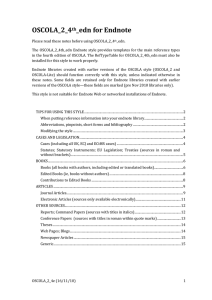Concise Guide to Footnote Referencing
advertisement
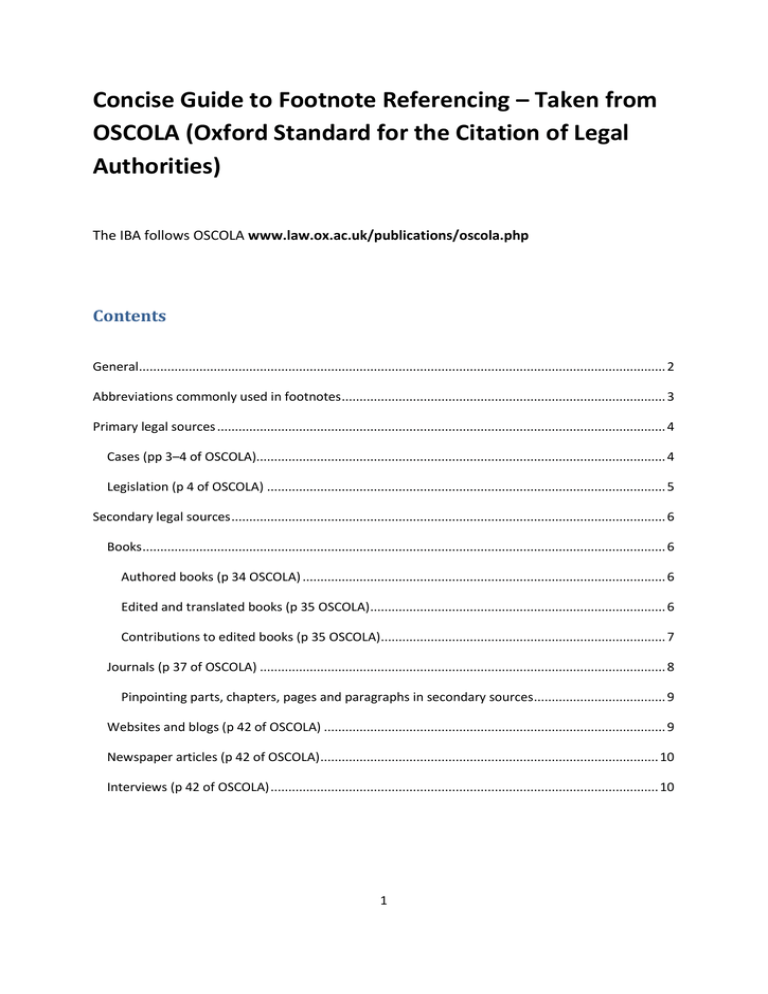
Concise Guide to Footnote Referencing – Taken from OSCOLA (Oxford Standard for the Citation of Legal Authorities) The IBA follows OSCOLA www.law.ox.ac.uk/publications/oscola.php Contents General.................................................................................................................................................... 2 Abbreviations commonly used in footnotes ........................................................................................... 3 Primary legal sources .............................................................................................................................. 4 Cases (pp 3–4 of OSCOLA)................................................................................................................... 4 Legislation (p 4 of OSCOLA) ................................................................................................................ 5 Secondary legal sources .......................................................................................................................... 6 Books ................................................................................................................................................... 6 Authored books (p 34 OSCOLA) ...................................................................................................... 6 Edited and translated books (p 35 OSCOLA) ................................................................................... 6 Contributions to edited books (p 35 OSCOLA)................................................................................ 7 Journals (p 37 of OSCOLA) .................................................................................................................. 8 Pinpointing parts, chapters, pages and paragraphs in secondary sources ..................................... 9 Websites and blogs (p 42 of OSCOLA) ................................................................................................ 9 Newspaper articles (p 42 of OSCOLA) ............................................................................................... 10 Interviews (p 42 of OSCOLA) ............................................................................................................. 10 1 General ‘There are two golden rules for the citation of legal authorities. One is consistency. The other is consideration for the reader. Legal writing is more persuasive when the author refers to legal materials in a clear, consistent and familiar way.’ OSCOLA Legal writing cites primary legal sources (cases, statutes and so on), as well as secondary sources such as books, journal articles, websites and policy statements. Indicate footnotes with a superscript number which should appear after the relevant punctuation in the text (if any).1 Put the footnote marker at the end of a sentence, unless for the sake of clarity it is necessary to put it directly after the word or phrase to which it relates. Close footnotes with a full stop (or other appropriate punctuation mark). Where more than one citation is given in a single footnote reference: put them in chronological order and separate them with semi-colons.2 OSCOLA uses as little punctuation as possible. Abbreviations and initials in author’s names do not take full stops. Be aware that footnotes in tables will not be part of the main footnote numbering, therefore, avoid putting footnotes in tables.3 1 Just like this example. 2 First reference; second reference. 3 Due to a quirk in the typesetting software (InDesign), footnotes in tables will not appear. 2 Abbreviations commonly used in footnotes and following – ff article/articles – art/arts chapter/chapters (of statutes) – c/cc clause/clauses – cl/cls footnote /footnotes (external to the work) – fn/fns footnote/footnotes (internal to the work) – n/nn for example – eg, number/numbers – no/nos number/numbers (of a report etc) – No/Nos page/pages – p/pp paragraph/paragraphs – para/paras part/parts – pt/pts regulation/regulations – reg/regs rule/rules – r/rr schedule/schedules – sch/schs section/sections – s/ss see a footnote mentioned previously in the report – see n**, above see the footnote directly above – Ibid subparagraph/subparagraphs – subpara/subparas subsection/subsections – sub-s/sub-ss that is – ie, volume/volumes – vol/vols NB If using eg or ie in a footnote, treat the same way as a number higher than ten – if it is the first thing in the sentence, write out in full; if it is within the sentence you may abbreviate to eg or ie.4 4 For example, we have written it out in full here as it started this sentence. But, if it was to come into the sentence here, eg, here, we abbreviate. 3 Primary legal sources Cases (pp 3–4 of OSCOLA) When citing cases in footnotes, give the name of the case; the neutral citation (if appropriate); volume number and first page of the relevant law report; and, where necessary, the court. If the name of the case is given in the main text, it is not necessary to repeat it in the footnote. It is well represented in the case law, perhaps most notably in the expression of the no-conflict rule advocated by Lord Upjohn in Phipps v Boardman,31 and in the earlier Court of Appeal decision in Boulting v Association of Cinematograph, Television and Allied Technicians.32 In Boulting [or ‘in the Boulting case’], Upjohn LJ said that the rule ‘must be applied realistically to a state of affairs which discloses a real conflict of duty and interest and not to some theoretical or rhetorical conflict’.33 In Phipps, Lord Upjohn developed his view of the rule further by adding that there must be a ‘real sensible possibility of conflict’.34 The relevant footnotes would appear as follows: 31 [1967] 2 AC 46 (HL). [1963] 2 QB 606 (CA). 33 Boulting (n 32) 638. OR 33 Ibid 638. 34 Phipps (n 31) 124. 32 The numbers at the end of footnotes 33 and 34 are called ‘pinpoints’; they give the page on which the quotation can be found. It is also acceptable to include the full case reference in all footnotes. 4 Legislation (p 4 of OSCOLA) A citation in a footnote is not required when citing legislation if all the information the reader needs about the source is provided in the text, as in the following sentence: This case highlights the far-reaching judicial role ushered in by the Human Rights Act 1998. Where the text does not include the name of the Act or the relevant section, this information should be provided in a footnote. British courts must only consider Strasbourg jurisprudence: they are not bound by it. 1 1 Human Rights Act 1998, s 2. 5 Secondary legal sources Books Authored books (p 34 OSCOLA) Cite the author’s name first – remember, in footnotes, the author’s first name or initial(s) precede their surname. The name is followed by a comma, and then the title of the book in italics (for more information, see section 3.1 of the full OSCOLA Guide). Where a book has a title and subtitle not separated with punctuation, insert a colon. Publication information follows the title within brackets. Publication elements should always include the publisher and the year of publication, with a space but no punctuation between them. The place of publication need not be given. If you are citing an edition other than the first edition, indicate that using the form ‘2nd edn’ (or ‘rev edn’ for a revised edition). Additional information should be of a clarifying nature: it may include the editor, the translator or other descriptive information about the work. author, | title | (additional information, | edition, | publisher | year). Timothy Endicott, Administrative Law (OUP 2009). Gareth Jones, Goff and Jones: The Law of Restitution (1st supp, 7th edn, Sweet & Maxwell 2009). Edited and translated books (p 35 OSCOLA) If there is no author, cite the editor or translator as you would an author, adding in brackets after their name ‘(ed)’ or ‘(tr)’, or ‘(eds)’ or ‘(trs)’ if there is more than one. 6 Contributions to edited books (p 35 OSCOLA) When citing a chapter or essay in an edited book, cite the author and the title of the contribution, in a similar format to that used when citing an article, and then give the editor’s name, the title of the book in italics, and the publication information. It is not necessary to give the pages of the contribution. author, | ‘title’ | in editor (ed), | book title | (additional information, | publisher | year). 7 Journals (p 37 of OSCOLA) When citing articles, give the author’s name first, followed by a comma. In footnotes, the author’s first name or initial(s) precede their surname. Then give the title of the article, in Roman within single quotation marks. After the title, give the publication information in the following order: year of publication, in square brackets if it identifies the volume, in round brackets if there is a separate volume number; the volume number if there is one (include an issue number only if the page numbers begin again for each issue within a volume, in which case put the issue number in brackets immediately after the volume number); the name of the journal in roman, in full or abbreviated form, with no full stops; and the first page of the article. author, | ‘title’ | [year] | ‘journal name or abbreviation’ | first page of article. [OR] author, | ‘title’ | (year) | volume | ‘journal name or abbreviation’ | first page of article. For guidance on journal abbreviations, see section 4.2.1 of the appendix in the main OSCOLA Guide. Abbreviations do vary, so choose an abbreviation and stick with it throughout your work. [Alternatively, www.legalabbrevs.cardiff.ac.uk can be helpful – but remember to remove full stops in abbreviations.] Some publishers prefer all journal names to be given in full. Paul Craig, ‘Theory, “Pure Theory” and Values in Public Law’ [2005] PL 440. Alison L Young, ‘In Defence of Due Deference’ (2009) 72 MLR 554. 8 Put a comma after the first page of the article if there is a pinpoint. JAG Griffith, ‘The Common Law and the Political Constitution’ (2001) 117 LQR 42, 64. Jeremy Waldron, ‘The Core of the Case against Judicial Review’ (2006) 115 Yale LJ 1346, 1372. Pinpointing parts, chapters, pages and paragraphs in secondary sources Pinpoints to parts, chapters, pages and paragraphs come at the end of the citation. Use ‘pt’ for part, ‘ch’ for chapter, and ‘para’ for paragraph. Page numbers stand alone, without ‘p’ or ‘pp’. If citing a chapter or part and page number, insert a comma before the page number. Where possible, give a specific range of pages. Websites and blogs (p 42 of OSCOLA) Where there is no relevant advice elsewhere in OSCOLA, follow the general principles for secondary sources when citing websites and blogs. If there is no author identified, and it is appropriate to cite an anonymous source, begin the citation with the title in the usual way. If there is no date of publication on the website, give only the date of access. NB IBA style differs from OSCOLA style here, in that URLs are styled as Bold, no underline. For example: www.un.org/en. IBA style does not use http:// unless there is no www in the address, for example: https://uncitral.org/en-index.htm. IBA style does not put a ‘/’ at the end of a URL. Sarah Cole, ‘Virtual Friend Fires Employee’ (Naked Law, 1 May 2009). www.nakedlaw.com/2009/05/index.html accessed 19 November 2009. 9 Newspaper articles (p 42 of OSCOLA) When citing newspaper articles, give the author, the title, the name of the newspaper in italics and then in brackets the city of publication and the date. Page numbers (pinpoints) can be included. Jane Croft, ‘Supreme Court Warns on Quality’ Financial Times (London, 1 July 2010) 3. Ian Loader, ‘The Great Victim of this Get Tough Hyperactivity is Labour’ The Guardian (London, 19 June 2008) www.guardian.co.uk/commentisfree/2008/jun/19/justice.ukcrime accessed 19 November 2009. Interviews (p 42 of OSCOLA) When citing an interview you conducted yourself, give the name, position and institution (as relevant) of the interviewee, and the location and full date of the interview. If the interview was conducted by someone else, the interviewer’s name should appear at the beginning of the citation. Interview with Irene Kull, Assistant Dean, Faculty of Law, Tartu University (Tartu, Estonia, 4 August 2003). Timothy Endicott and John Gardner, Interview with Tony Honoré, Emeritus Regius Professor of Civil Law, University of Oxford (Oxford, 17 July 2007). 10
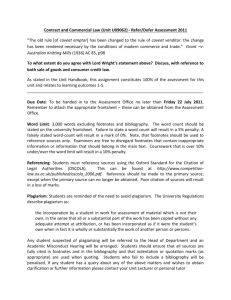
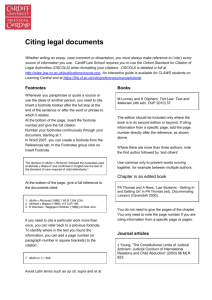
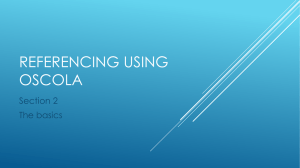
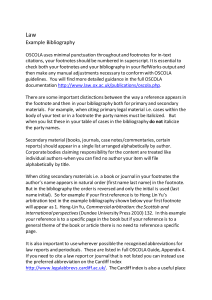
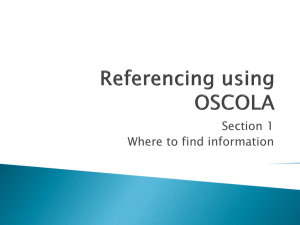
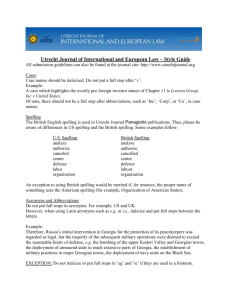
![[title] Writing a Research Paper](http://s2.studylib.net/store/data/015952607_1-a24021a8b99597e61da77de3c7ee9906-300x300.png)
